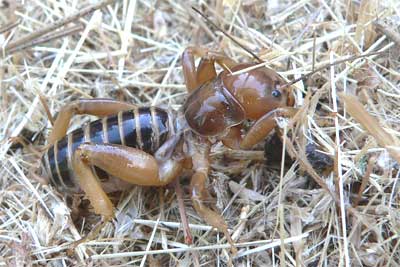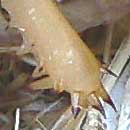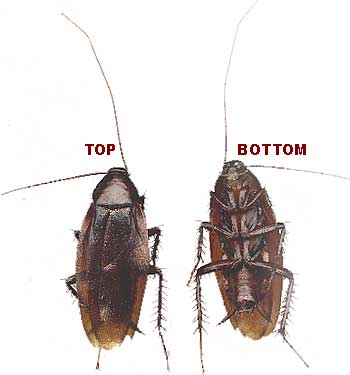Orthoptera
(grasshoppers, crickets, mantids, etc.)
- wings: 0-4, FW narrow & thick
- mouth: chewing
- tarsi segments: 3-5
- metamorphosis: simple

English Name: Jerusalem Cricket
Family: Gryllacrididae (Camel Crickets & others)
Subfamily: Stenopelmatinae
Genus: Stenopelmatus
Species: fuscus
Notice that this kind of cricket doesn't belong to the Cricket Family, the Gryllidae. Members of the Camel Cricket Family to which Jerusalem Crickets belong are typically wingless and gray or brown, not like regular house and field crickets, which usually bear wings and are black. Being wingless, the males don't have sound-producing structures on front wings, which regular crickets definitely do. The body of the Jerusalem Cricket in the picture above is 1.3 inches long (3.4 cm). Note the thick, powerful legs equipped with sharp spines, as shown in the close-up at the left. Those spines are on the above cricket's back-leg tibia. In North America Jerusalem crickets are western, occurring mainly along the Pacific Coast. They're nocturnal, spending their days beneath objects on the ground or in loose soil. I found the one shown here beneath a pile of lawn clippings. One last thing -- these big insects are carnivorous and they know how to bite a finger -- though their bite surprises you more than hurts...
Being wingless, the males don't have sound-producing structures on front wings, which regular crickets definitely do. The body of the Jerusalem Cricket in the picture above is 1.3 inches long (3.4 cm). Note the thick, powerful legs equipped with sharp spines, as shown in the close-up at the left. Those spines are on the above cricket's back-leg tibia. In North America Jerusalem crickets are western, occurring mainly along the Pacific Coast. They're nocturnal, spending their days beneath objects on the ground or in loose soil. I found the one shown here beneath a pile of lawn clippings. One last thing -- these big insects are carnivorous and they know how to bite a finger -- though their bite surprises you more than hurts...

English Name: Wood Cockroach
Family: Blattidae (cockroaches)
Genus: Parcoblatta
Species: ?
Though many cockroach species exist, only about four are commonly encountered in North American homes and backyards. They are the American, German, Oriental and Wood Cockroaches. The Wood Cockroach shown above managed to enter my trailer parked in the woods, and that is exactly where you would expect to find this species. The Cockroach Family is distinguished from other Orthopteran families by its members having flattened, oval bodies, with the head mostly or entirely concealed from above by the overarching upper surface of its thorax, known as the pronotum. Its long, slender antennae also are pretty special. Cockroaches have been around since long before the dinosaurs, so in a way they are "living fossils."
 English Name: Two-striped Walkingstick
English Name: Two-striped Walkingstick
Family: Phasmatidae (walkingsticks)
Genus: Anisomorpha
Species: buprestoides
In mid summer this walkingstick is abundant around, on and beneath my trailer in southwestern Mississippi, though when I was a kid in Kentucky I never saw it. It must be a Deep South species. This is not the common walkingstick usually portrayed in books, though it's similar. The common one is more slender and has even longer legs. One interesting thing about walkingsticks is that they are so large -- one southern species reaches 6 inches (15 cm) and longer. Another reason they are interesting is because of their twiglike appearance. One reason they look like twigs is because often they are found on trees and bushes, feeding on plant material, so looking like a twig makes them harder to see for predators. Looking like a twig is their camouflage. Walkingsticks are closely related to Praying Mantises, but mantids belong to a different family. Some tropical members of the Walkingstick Family get even larger than ours, and more curious-looking. One African species gets 11 inches long (28 cm). Also, some phasmid family members instead of imitating twigs look like leaves. One species in the East Indies looks just like two leaves stuck together. Its body is flat and almost as thin as a real leaf. This family really specializes in camouflage!

English Name: Carolina Mantid
Family: Mantidae (mantids)
Genus: Stagmomantis
Species: carolina
This species often catches our eye simply because it's so large. The one in the picture is 2.5 inches long (6.4 cm). The features that make it recognizable as a mantid are its conspicuous "arms" adapted for grabbing and holding pray, its long and slender neck area, or prothorax, and its head, which can be turned atop the "neck" in a way that enables it to look around in a very un-insectlike way! Two other mantid species are more common nationwide than the Carolina Mantid shown above. The Chinese Mantid, Tenodera aridifolia, reaches four inches (10 cm) in length. It is usually bright green, tan, or a combination of those colors. The species was introduced to the U.S. from China in the late 1800's as a potential beneficial insect. The European Mantid, Mantis religiosa, is usually tan or green, but is usually much smaller (2-3 inches). The European mantid originated in Europe and was accidentally introduced into the US in the 1800's.